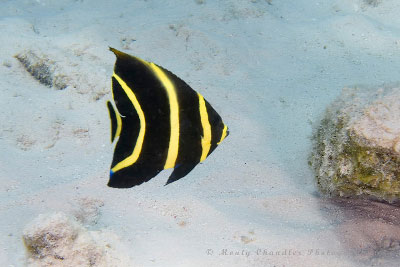The Most Beautiful Fish in Cuba
Carlos Fraguela

HAVANA TIMES — Though the summer beach season hasn’t officially started, I am already eager to go snorkeling at the coast. Seen through my swimming goggles, the afternoon is an adventure filled with thrilling discoveries – an experience which the ravages of pollution and human excess threaten to do away with entirely.
Today, at the sea, I came across one of Cuba’s most beautiful fishes again. The few facts I know about it are fascinating and I would like to devote a few lines to these.
Though still a young five to six-centimeter specimen at this time of the year, this fish plays a very important ecological role in Cuba’s waters.
Found near the coastline, it is considered a “cleaner”, feeding on crustaceans which parasitize other fish species. The sea is teeming with parasitic crustaceans swimming in search of a host to adhere to.
Though it is said fish have a very limited intelligence, some seem very well adapted to their environment and appear to know exactly where to look for the help they need.
The barber fish is one case in point. Upon feeling that small crustaceans have adhered to its scales, it goes in search of a helper fish. A long school of barber fish, waiting to be cleaned by Cuba’s most beautiful fish, is a breathtaking spectacle indeed.
It’s no easy task, mind you. Sometimes, extracting the parasites can be painful process, but the host fish bravely endures it, knowing that relief will invariably follow. The whole ceremony can last a few minutes. In the end, everyone (save the crustaceans) swims away happily.
Barber fish aren’t the only ones who seek out the services of this most competent of underwater cleaners. Maiden fish and other species also request the aid of this blessed being that frees them from pain, feeding on parasites as part of a symbiotic process.
Having observed it closely, I have come to the conclusion that it makes use of its beautiful colors to draw the attention of fish that require its assistance. When no cleaning duty is in sight, it simply swims about, care-free.
Thanks to a friend who is a biologist, I was able to learn the scientific name of this fish while nearing the conclusion of these lines: Pomacanthus arcuatus.
Using this name in an Internet search, I came across a very interesting piece of information: when they become adults, these fish swim in schools made up of a male and a “harem” of three or four females. If the male dies, one of the females changes its gender to fill the vacated position, a strategy which guarantees the conservation of the species.





